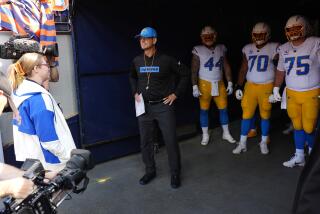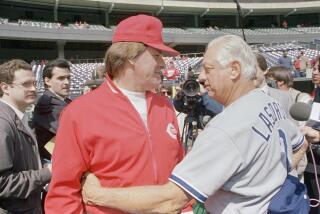If You Have to Faint, Do It While Lobbying
One afternoon in February, rising to debate with striped-shirted incompetents, the Duke University basketball master Mike Krzyzewski fainted.
He did it casually, almost as if bending down to tie his shoes, then curled up for a nap on the court named for him.
âOver my 30 years of coaching,â Krzyzewski said, âitâs happened a number of times. I donât know if itâs ever happened to you, but when you get up real quick, sometimes you get lightheaded. I felt like a chump. Like someone hit me with an air punch and Iâm out. Iâm thinking, âWhat an idiot ... â â
I know the feeling.
It was about 8:30 on the Thursday morning after the Super Bowl. I stood outside the elevators in a hospital lobby, anxious to visit my wife. Also, in a half-hour I was to call Tony La Russa, who had begun a media campaign to defend his old star and friend, Mark McGwire, again drawn into baseballâs steroid mess, this time by accusations coming from another of La Russaâs former stars, Jose Canseco.
Cansecoâs claims of McGwireâs steroid use were specific and more persuasive than any evidence involving, say, Barry Bonds. I had heard some of La Russaâs criticism already: He said Cansecoâs charges grew from jealousy and envy of McGwireâs success. But, I thought, that didnât address the real issue.
Only Canseco and McGwire could know if they shared a menâs room stall to inject steroids in each otherâs buttocks. (Now, there is a sentence they donât teach you in Sportswriting 101.) So I expected an uncomfortable talk with the Cardinals manager, one in which I would say that demeaning the messenger did not disprove the message.
Instead, I fainted.
Not that I knew it. Last thing I remember is getting suddenly dizzy. Next thing, I was on my back somewhere with somebody pushing something against both sides of my head and then running tape across my forehead and my chin.
At that point, I spoke. I spoke more colorfully than Coach K. My precise words were, âWhat the &! ?â I spent the next six days in the hospital.
And I am here to tell you that if you have to fall straight back onto your head, a hospital lobby is a good place to do it. I could have fainted driving 80 miles per hour from Jacksonville to Fort Lauderdale, where I did an interview with Muhammad Aliâs old trainer, Angelo Dundee. Faint on that I-95 superspeedway, youâre really &! ed.
âI spent three months in Australia working with Russell Crowe,â Dundee said. He turned the actor into a facsimile of the 1935 heavyweight champion James J. Braddock for Croweâs next movie, âCinderella Man.â âIâve had 16 champs,â Dundee said, laughing, â15 of âem legitimate and one shonky,â shonky being the Aussie slang equivalent of our cheesy.
Anyway, I became famous among the hospital inmates as âthe MSET from the lobby.â
MSET is an acronym for the hospitalâs Medical/Surgery Emergency Team. A young woman told me, âUsually, our calls are false alarms. Yours was nice and bloody.â
(Gee, thanks. An emergency room tailor sewed my head together, 21 stitches.) And she asked, âDid it hurt much?â
No reason she would know Alex Johnson, a surly character and outfielder with the Reds of the late 1960s. But her question fits in a story Pete Rose loved to tell. By Roseâs account, Johnson was hit so squarely in the forehead by a pitch that the ball ricocheted over the shortstopâs head. âThere was this amazing sound: BOING!â Rose said.
Soon, a grapefruit grew from Johnsonâs brow. George Ballou, the team doctor, fretted about the playerâs health. The more Ballou hovered around him, the testier Johnson became until finally he told the doctor, âLook, it didnât hurt. It just made a big noise inside.â
Mine didnât hurt. Nor was there noise. Not when youâre already unconscious. Here, let me say that sportswriters often write, blithely, âFollowing an MRI yesterday, Joe Biceps returned to action
As if an MRI were a photograph.
Fall on your head, and this is how a Magnetic Resonance Imaging deal goes: They slide your whole body into a coffin -- I mean, a metal tube. In the gathering presence of claustrophobia, you lay still for 45 minutes. The machineâs magnets clang around you. You try to remember what it was like to be alive and well.
The MRI report on my head said: âIntracranially, there is normal appearance of the distal cervical, petrous, cavernous, and supraclinoid internal carotid artery segments. There is normal appearance of the anterior and middle cerebral arteries and their proximal branches. Posteriorly, the interdural vertebral arteries and basilar artery are normal. There are no significant stenoses. There are no aneurysms or other vascular lesions.â
In other words, âX-Rays of Kindredâs Head Show Nothing.â
And I am happy to report it.
More to Read
Go beyond the scoreboard
Get the latest on L.A.'s teams in the daily Sports Report newsletter.
You may occasionally receive promotional content from the Los Angeles Times.










